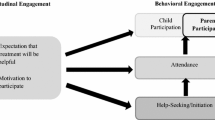Abstract
This study examined whether the American family preservation program Families First was successfully implemented in the Netherlands. Data were collected on 250 children of 177 families who received Families First. At the start of treatment 78% of the children appeared to have serious behavioral problems, 67% of the parents experienced a high level of parental stress, and 63% of the children went through a substantial number of life events during the year preceding the treatment. On average the treatments had the intended duration (about 4 weeks), intensity (about 10 hours a week) and availability (during working hours as well as in evenings and in weekends), and family workers did adhere to important guidelines of treatment delivery. One year after treatment 76% of the children were still living at home. Moreover, children's behavioral problems, parental stress and the number of life events turned out to be significantly decreased. It was concluded that Families First had reached its intended target group, delivered the treatment as intended, and achieved its intended outcomes, suggesting a successful implementation in the Netherlands.
Similar content being viewed by others
References
Smit M, Knorth EJ, Klomp M: Child and youth care in the Netherlands. Services and developments. Child and Youth Care Forum 26: 311–321, 1997.
Blythe BJ, Patterson Salley M, Jayaratne S: A review of intensive family preservation services research. Social Work Research 18: 213–224, 1994.
Scannapieco, M: Home-based services program. Effectiveness with at risk families. Children and Youth Services Review16: 363–377, 1994.
Van Acker JCA, De Kemp RAT: The Family Project Approach. J Adolesc 20: 419–430, 1997.
Weiner A, Kuppermintz H, Guttmann D: Video Home Training (The Orion Project). A short-term preventive and treatment intervention for families with young children. Fam Process33: 441–453, 1994.
Kinney J, Haapala D, Booth C: Keeping Families Together. The Homebuilders model. New York: Aldine de Gruyter, 1991.
Spanjaard H, Berger M: Families First. Hulp aan gezinnen ter voorkoming van uithuisplaatsing van kinderen. [Families First: Assistance to families to prevent out-of-home placement of children.] Jeugd en Samenleving 12: 720–729, 1994.
Rossi PH: Evaluation of Family Preservation Programs. A Report to the Edna Mc-Connell Clark Foundation. Amherst, MA: Social and Demographic Research Institute, University of Massachusetts, 1991.
Bath HI, Haapala DA: Family preservation services. What does the outcome of research really tell us? Social Service Review 68: 386–404, 1994.
Fraser MW, Nelson KA, Rivard JC: Effectiveness of family preservation services. Social Work Research21: 138–153, 1997.
Schuerman JR, Rzepnicky TL, Little JH: Putting Families First. An Experiment in Family Preservation. New York: Aldine de Gruyter, 1994.
Wells K, Whittington D: Child and family functioning after intensive family preservation services. Social Service Review 67: 55–83, 1993.
Jacobs FH: The five-tiered approach to evaluation: context and inplementation. In Evaluating Family Programs, eds. Weiss, HB, Jacobs, FH. New York: Aldine De Gruyter, 1988, pp. 37–68.
Friedman R: Services and service delivery system for children with serious emotional disorders: issues in assessing effectiveness. In Children's Mental Health Services, Vol. 3., eds. Nixon, CT, Northrup, DA. Thousand Oaks, CA: Sage, 1997, pp. 16–44.
Connell JP, Kubisch AC: Applying a Theory of Change approach to the evaluation of comprehensive community initiatives: progress, prospects and problems. In: New Approaches to Evaluating Community Initiatives, eds. Fulbright-Anderson, K, Kubisch, AC, Connell, JP. Washington, DC: The Aspen Institute, 1998, pp. 15–44.
Achenbach T:. Integrative Guide for the 1991 CBCL/4-18, YSR, and TRF Profiles. Burlington, VT: University of Vermont, Department of Psychiatry, 1991.
Verhulst FC, Van der Ende J, Koot HM: Handleiding voor de CBCL/4-18 [Manual of the CBCL/4-18]. Rotterdam: Erasmus Universiteit/ Sophia Kinderziekenhuis, Afdeling Kinder-en Jeugdpsychiatrie, 1996.
Wels PMA, Robbroeckx LMH: Handleiding bij de Nijmeegse Vragenlijst voor de Opvoedingssituatie (NVOS) [Manual of the Nijmegen Child-rearing Situation Questionnaire (NCSQ)]. Lisse, the Netherlands: Swets & Zeitlinger, 1996.
Coddington RD: The significance of life events as etiologic factors in the diseases of children, II: a study of a normal population. J Psychosom Res 16: 205–213, 1972.
Veerman JW, Ten Brink LT, Van der Horst H, Koedoot P: Handleiding Vragenlijst Meegemaakte Gebeurtenissen (2e herziening). [Manual of the Questionnaire of Life Events (2nd rev.)]. Duivendrecht, the Netherlands: Paedologisch Instituut, 1997.
Ten Brink LT, Veerman JW, De Kemp, RAT, Berger, M: Implemented as intended? Recording family worker activities in a Families First program, under revision.
Cohen J: Statistical Power Analysis for the Behavioral Sciences. 2nd ed. Hillsdale, NJ: Lawrence Erlbaum, 1988.
Scholte EM: Criteria for residential and foster care. International Journal of Child Psychology & Psychiatry 38: 657–666, 1997.
Scholte EM: Psychological risk characteristics of children in welfare programs in Holland: the role of risk-factor analysis in the planning of welfare services for children. Childhood. A Global Journal of child research5: 185–205, 1988.
De Kemp RAT, Veerman JW Ten Brink LT: The assessment of imminence of risk of placement. Lessons from a Families First program in the Netherlands. Children and Youth Services Review, in press.
Ten Brink LT: De verdere ontwikkeling van kinderen tijdens een periode van klinische jeugdzorg. Status, beloop, prognose [The development of children during a period of clinical youth care]. Doctoral dissertation, Amsterdam, Free University, 1998.
Kloosterman MV, Veerman JW: Boddaert Belicht. Eindrapport Interventie-onderzoek Boddaert [Final report of the day treatment intervention study]. Utrecht: VOG, 1999.
Kazdin AE: Conduct Disorders in Childhood and Adolescence. 2nd ed. Thousand Oaks, CA: Sage, 1995.
Author information
Authors and Affiliations
Rights and permissions
About this article
Cite this article
Veerman, J.W., de Kemp, R.A., ten Brink, L.T. et al. The Implementation of Families First in the Netherlands: A One Year Follow-Up. Child Psychiatry Hum Dev 33, 227–244 (2003). https://doi.org/10.1023/A:1021456630670
Issue Date:
DOI: https://doi.org/10.1023/A:1021456630670



